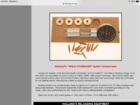One thing is certain - whatever a bullet looks like and measures while holding it, it will not look and measure the same as it comes out of the barrel. It will be mashed and most likely elongated to conform to the lands and groves of the barrel and have some degree of copper jacket stripped off. For this reason, measuring bullet for me takes the form of finding big outliers and the only important measurement to me is the point on the ogive that is the same diameter as the lands and the distance of this point to or into the lands.
Install the app
How to install the app on iOS
Follow along with the video below to see how to install our site as a web app on your home screen.
Note: This feature may not be available in some browsers.
You are using an out of date browser. It may not display this or other websites correctly.
You should upgrade or use an alternative browser.
You should upgrade or use an alternative browser.
BBTO or bearing surface?
- Thread starter ckaberna
- Start date
Be careful, if you don't mark the two comparators and get them mixed up, all your loading data won't work. Test them bto only on the same loaded round and you will probably get a different reading.Where is the most “bang” for your time sorting by bullet base to o-give or bearing surface for BR accuracy?
I have sorted some Berger 108’s by bearing surface using two hornady comparators but I can still see difference in them when comparing base to ogive.
it isn't like a comaparator has a lot of moving parts or any sensitive adjustments. The only error possible is operator error or a malfunction in the measuring device. The diameter of the hole in the metal will not change if you measure the same bullet three times and get three different reading either the calipers or the operator is to blame
I don't know if this will help but I "spin" the bullet or case in the comparitor while gently squeezing the calipers jaws snug with the other hand with a light source behind the measuring tool, the bullet or case tends to center itself and you can try make sure the base is level with the caliper jaws. That is how I use a Hornady comparitor, I am sure it would work with others
Similar threads
- Replies
- 2
- Views
- 1,102
- Replies
- 8
- Views
- 2,262
- Replies
- 34
- Views
- 4,780
Upgrades & Donations
This Forum's expenses are primarily paid by member contributions. You can upgrade your Forum membership in seconds. Gold and Silver members get unlimited FREE classifieds for one year. Gold members can upload custom avatars.

Click Upgrade Membership Button ABOVE to get Gold or Silver Status.
You can also donate any amount, large or small, with the button below. Include your Forum Name in the PayPal Notes field.
To DONATE by CHECK, or make a recurring donation, CLICK HERE to learn how.

Click Upgrade Membership Button ABOVE to get Gold or Silver Status.
You can also donate any amount, large or small, with the button below. Include your Forum Name in the PayPal Notes field.
To DONATE by CHECK, or make a recurring donation, CLICK HERE to learn how.










